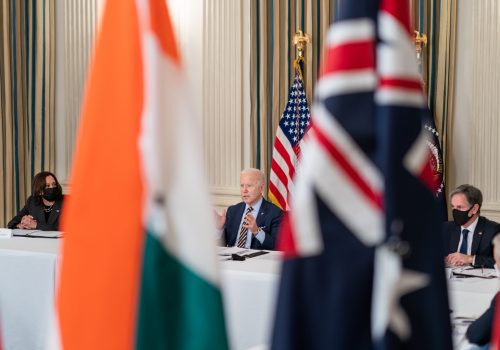Experts react: The US, UK, and Australia struck a nuclear submarine deal. What does it mean?
On Wednesday, US President Joe Biden, UK Prime Minister Boris Johnson, and Australian Prime Minister Scott Morrison announced a new defense partnership among their nations that will furnish Australia with new nuclear-powered submarines. The pact, known as AUKUS, is a clear challenge to China in the Indo-Pacific and a deepening of military ties among close allies of more than a century. But it could ruffle the feathers of other allies. Our Atlantic Council experts break down the implications.
Check back in: This post will be updated as the story develops.
Jump to an expert reaction
Barry Pavel: A new level of deterrence against China
Matthew Kroenig: How to sink a navy in three days
Peter J. Dean: The view from Australia: A huge step forward
Ben Haddad: A major blow to Paris
A new level of deterrence against China
The AUKUS alliance initiative, which I heartily applaud as one of many that will be required in the coming years to keep pace with Chinese advances, will have manifold implications as it continues to play out. The Biden administration is taking an important step to build a key alliance element of the edifice required for the new era.
First, it will have geostrategic implications, as it tangibly strengthens the closest alliance relationships that the United States shares with allies in both the Indo-Pacific and Europe—the United Kingdom and Australia in particular. A major signal from this alliance initiative, the “AUKUS alliance,” of which China will take note, is that a European ally of the United States is joining an Indo-Pacific ally of the United States in working together to develop undersea capabilities and to patrol the seas of the Pacific, and doing so through cooperation around one of the most sensitive combat systems in modern inventories. This signals to China that European allies take China’s ongoing coercive military operations in the western Pacific (for example, against Taiwan and in the South China Sea) as seriously as do America’s Indo-Pacific allies.
Second, it will have particularly constructive operational military implications, strengthening the ability of the United States-led alliances to deter Chinese military coercion even as Chinese capabilities continue to develop rapidly. Undersea capabilities are critical for preventing the Chinese military from achieving its operational objectives in the most important likely contingencies in the region. A key parameter of this new trilateral alliance will include US submarine access to Australian support infrastructure, thereby strengthening the overall US and allied increasingly “latticed” global defense posture (more of which will emerge after the National Defense Strategy review is completed). In addition, this initiative will also further strengthen the already close defense industrial cooperation among the United States, Australia, and the United Kingdom on some of the key technologies that will be of highest importance for future military effectiveness, including artificial intelligence, cyber, and long-range precision strike capabilities.
Those critics who say that China will react and that this will lead to a new arms race are missing the big picture: There is a decades-long trend that has only accelerated under Xi Jinping in which China has been developing high-tech, leading-edge advanced military capabilities across the board. The parameters of likely military contingencies in the Indo-Pacific suggest that the United States and US allies have a lot of work to do in order to buttress a weakening deterrent posture in the context of rapid Chinese People’s Liberation Army advances. This is one small but important step in doing just that.
The interesting echo of history that this initiative represents harkens back to the Eisenhower administration’s policy of sharing nuclear technology with the UK, a policy that caused French President Charles de Gaulle to decry the “Anglo-Saxon” nuclear cooperation and propelled France to develop its own nuclear capabilities. In light of the broad set of strategic challenges that China’s continuing rise presents to the breadth of US alliances, it would be wise for the Biden administration to follow up this set of steps by developing analogous cooperative efforts with France, Japan, South Korea, and other leading allies.
—Barry Pavel is senior vice president and director of the Scowcroft Center for Strategy and Security at the Atlantic Council and former top US Defense Department and National Security Council official.
How to sink a navy in three days
To deter Chinese military aggression, Washington and its allies need the ability to sink the Chinese navy in seventy-two hours. The attack submarines we are helping Australia to build are tailor-made for destroying enemy warships. These are exactly the capabilities we need in the Indo-Pacific to shore up deterrence and defense against China.
It makes sense that Australia is the partner of choice for these capabilities. Australia is one of the United States’ closest allies. We fought side-by-side for over a century in World War I, World War II, Korea, Iraq, and Afghanistan. Now, with this deal, we stand shoulder-to-shoulder once again against the growing Chinese military threat.
—Matthew Kroenig is the deputy director of the Atlantic Council’s Scowcroft Center for Strategy and Security and the director of the Center’s Scowcroft Strategy Initiative, as well as former senior US Defense Department and intelligence official.
The view from Australia: A huge step forward
In a press conference that lasted less than twelve minutes today, the Australian defense landscape, as well as relations between Australia, the United States, and the United Kingdom were transformed. The lead line was AUKUS (pronounced ORCUS), a “new enhanced trilateral security partnership,” but the headline-maker is this group’s first initiative—nuclear-powered submarines for Australia.
This is a massive leap forward from all parties. While Australia is the recipient of this capability, the decision says far more. In the United States, it shows the willingness of the Biden administration to empower key allies with advanced military technology that it had, until now, been unwilling to share. It’s a major step forward in the US-Australia relationship and a precursor of what’s to come in enhancing the bilateral partnership. We should learn more at the AUSMIN meeting later this week. For the UK, it gives credence to their new “Global Britain” strategic outlook and is a major step forward for the UK defense industry and relations with Australia and the US.
From a pure capability perspective, nuclear-powered attack-class submarines are a no-brainer for Australia. Australia already possesses some of the most capable conventional submarines in the world, but the difficulties of long transit times to key operational areas and the limitations of conventional submarines have long plagued Australia’s defense strategy. The now-scrapped future attack-class submarines, which had been under development with France, would have been the largest conventional submarines in the world.
Nuclear-powered submarines were seen as the solution to these operational problems, but for years they had only been spoken about by the Australian strategic community in dark corners. Political concerns over nuclear power, the lack of a domestic nuclear power industry, build and maintenance difficulties, and nuclear-waste disposal were all raised as inhibitors to this move. However the biggest hurdle was always seen to be the United States’ unwillingness to share the crown jewels of its nuclear technology. With that barrier now smashed, the other concerns fall away to issues of planning and execution to solve.
The short press conference does leave us with more questions than answers. Is there any quid-pro-quo in the offing from Australia for US or UK global force posture? Where to next for AUKUS, and how will this new trilateral relationship develop? How much will these submarines cost and how long will it take for them to come into service? Will they be based on a US or UK design? How many will be built? What happened to the attack-class deal with France and will this set back the bilateral Australian-French strategic relationship?
While these questions (and many more) will need to be answered in due course, this represents a major step forward for these three countries, for Australian capability and its ability to contribute to allied submarine capability in the region. Overall, as President Biden noted at the press conference, “today is a historic step.”
—Peter J. Dean is a nonresident senior fellow at the Atlantic Council’s Scowcroft Center for Strategy and Security’s Forward Defense practice and director of the Defence and Security Institute at the University of Western Australia.
A major blow to Paris
The surprise announcement of AUKUS on Wednesday will create a shock in Paris, which had signed a contract with Australia in 2017 over submarine delivery, which Canberra canceled this week to join US and UK partners. The French foreign minister, in a blunt communiqué, denounced the decision as “contrary to the letter and the spirit of the cooperation that prevailed between France and Australia.”
On the eve of the publication of the European Union strategy in the Indo-Pacific, and as Paris has risen as the main EU strategic actor in the region, this move will create a blow to transatlantic strategy in the region and create a lasting hurdle in US-France relations. While motivations in the US may have been primarily commercial, this Australian submarine contract was seen in Paris as part of a larger strategic effort in the region, and will undoubtedly embolden those in Paris who have expressed doubts over the relationship with the United States.
—Benjamin Haddad is the director of the Atlantic Council’s Europe Center.
Further reading
Image: A US Navy service member sits near the USS North Carolina (SSN-777) submarine docked at Changi Naval Base in Singapore April 28, 2014. Photo by Edgar Su/Reuters


